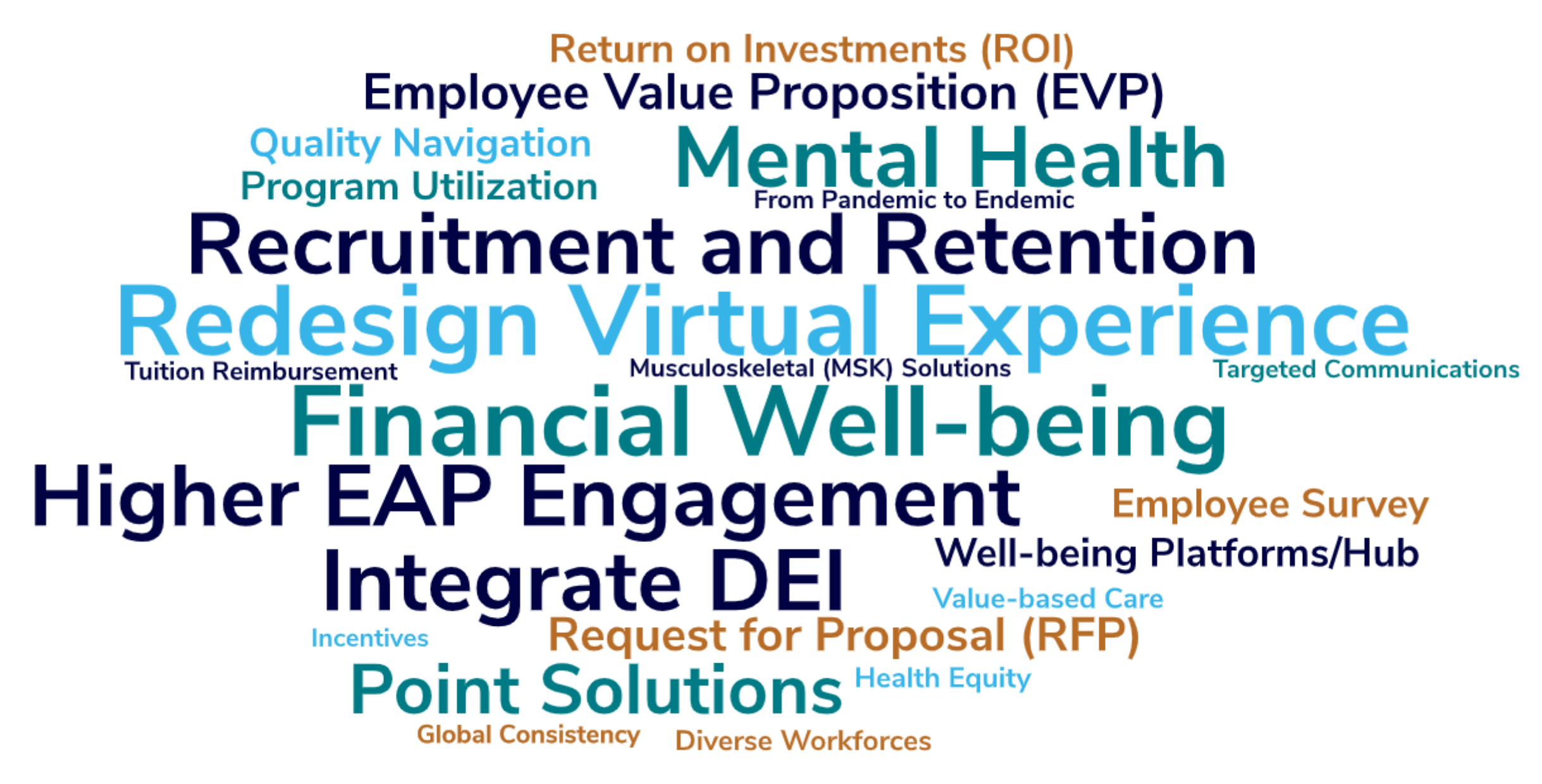February 24, 2022
After 2 years of focusing acutely on COVID-19, many employers are looking to 2022 as a year of change - both in terms of benefit offerings and the underlying considerations that go into designing new initiatives. Business Group on Health hosted calls among 11 different industry groups to discuss employers’ ongoing health and well-being initiatives along with future approaches to consider implementing in 2022.
These key insights recap some of the best practices and proactive approaches shared by employers on the calls in six key topic areas: open enrollment, quality health care, well-being initiatives, leave/time away, awareness campaigns and overall goals for 2022.
 Open Enrollment
Open Enrollment
In general, employers across all industries experienced an uneventful open enrollment period this year with only a few benefit changes.
|
Several health care companies had a rather quiet open enrollment period (i.e., no price increase or premium increase). Most employers in this industry are primarily focused on the retention and recruitment of their health care workers due to an increasingly competitive job market and unprecedented levels of wage inflation. |
|
|
Voluntary benefits were added by employers across industries. One aerospace and defense company rolled out a couple of voluntary benefits (e.g., identity theft protection), which had high uptake. In addition, this company is looking at implementing long-term care next year. A telecommunications and technology company shared that it did not make any health plan changes but did successfully move to a whole new platform for its benefits solutions. |
|
|
A number of employers in the pharmaceutical, biotech and medical product industry changed vendors for their life insurance provider. Another switched its PPO (preferred provider organization) to an EPO (exclusive provider organization) and focused primarily on communicating this change to employees (this company leveraged vendors to do the bulk of the communications on new offerings). |
 High-Quality Care
High-Quality Care
Ensuring the high quality of care offerings is an ongoing top priority for large employers across all industries. As COVID-19 continues to impact employees’ well-being and access to health care, ensuring the high quality of virtual care solutions, infertility benefits, adoption assistance programs and transgender support is just as important.
|
One company in the government, education, and nonprofit industry expanded employee access to virtual care early in the pandemic - providing mental health and dermatology at a $0 copay. Another company in the education industry expanded its internally managed employee assistance program (EAP), offering more virtual capabilities and adding staff to cut down on wait times. |
|
|
To address existing gaps in care, employers across several different industries added or enhanced their fertility and surrogacy coverage. For example, one employer in the government, education and nonprofit industry changed its eligibility criteria to no longer require a medical definition of infertility. An aerospace and defense company added a second-opinion provider. The benefits team at this company is also working on integrating employees from last year’s acquisitions into their broader benefits pool. One technology/telecommunications company enhanced its infertility benefit by removing the infertility diagnosis requirement and increasing the lifetime maximum amount from $10,000 to $20,000 (in-network only). This company also increased its adoption benefit from, $2,000 to $15,000. |
|
|
A couple companies enhanced their transgender benefits and support. For example, one technology company introduced a physician advocacy program for transgender and nonbinary employees. Another technology company expanded the coverage of its transgender transition program, from a $75,000 lifetime maximum to unlimited coverage. |
 Well-being
Well-being
Employers are increasingly applying new tactics to address well-being and its interconnected dimensions (i.e., mental, physical, social, financial) as a part of their overall company culture and strategy—positioning well-being initiatives at the center of the employee experience. To achieve this, employers are beginning to build and implement well-being dashboards or well-being platforms that utilize various metrics (e.g., vaccine attestation, daily steps, sleep tracking, food/nutrition diary and many more) to tally and incentivize behaviors and activities that improve well-being. Employers are also shifting more focus toward implementing preventive measures to address top conditions that impact employee well-being, including obesity, sleep disorders, musculoskeletal (MSK) and cardiovascular conditions.
|
One employer in the government, education and non-profit industry is rolling out new communications about well-being (e.g., employee-facing website, infographics, informative videos and QR codes) and is looking at new dependent care and retirement solutions. In addition, this employer created an employee-funded hardship fund and holds a campus-wide work group to address childcare issues. |
|
|
Another company in the consumer products industry launched a lifestyle spending account in the beginning of the year, where benefit-eligible employees can receive $500 to put toward anything they think will help improve their well-being. |
|
|
One aerospace and defense employer added a new plan where employees can earn money if they complete at least one preventive exam. Employees receive $500 to their health reimbursement arrangement (HRA) and another $1,000 to their retirement account. Employees can access these HRA funds immediately, while the retirement funds are available once they retire. |
|
|
After a huge effort to communicate with new employees about the programs that were available to them, one health care employer “reimagined” their well-being programs into a multidisciplinary and multistakeholder approach. As part of these efforts, this company linked its well-being intranet page onto all desktops for easy and direct access. In addition, the company used QR codes as another way to connect employees with available programs. As a result, the company experienced a 20% increase in utilization of its well-being resources. |
 Awareness Campaigns
Awareness Campaigns
Companies across all industry calls are hosting awareness campaigns to spotlight a variety of pertinent health and well-being issues affecting their workforces. Most employers plan to hold mental health campaigns during Mental Health Awareness Month in May. In addition, some employers hosted awareness campaigns on more specialized topics, such as navigating a cancer diagnosis, caregiving, promoting physical well-being and work/life balance.
|
One pharmaceutical company held mental health awareness campaigns for World Mental Health Day in October. In addition, its CEO gave employees an extra day off and is continuing a policy of synchronous days off to be given sporadically throughout the year. |
|
|
A technology company hosted several different awareness campaigns that included one about work/life balance, a global fitness challenge, mental health awareness and a campaign during infertility month. This company is also broadening its awareness campaigns in 2022 to include more content on fitness and adding new modalities to count steps for its global fitness challenges. |
|
|
Another company also plans to host awareness campaigns on different well-being related topics scheduled throughout the year. This includes a campaign during Mental Health Awareness Month and campaigns that encourage teleworkers to be more active by taking more walks throughout their workday. |
|
|
Along with mental health campaigns, one health care company had targeted communication campaigns about caregiving in 2021 in an effort to better highlight its available programs. |
 Leave Programs
Leave Programs
In an effort to attract and retain employees in a particularly competitive labor market (especially in the health care industry and for hourly/low-wage workers in industries such as retail and manufacturing), employers are enhancing leave allowances for employees. On top of that, many employers are continuing to offer COVID-19 related leave time for employees despite original plans to sunset by 2022. Several companies also added Juneteenth as a paid holiday.
|
In the retail industry, employees crave more flexibility. As a result, many large employers are reconstructing internal leave policy/structures. For example, one company overhauled its holiday leave benefit to include two fixed holidays and six holidays that can be taken at any time the employee chooses. |
|
|
One company in the government, education and nonprofit industry allows employees to transfer their unused PTO to student loan debt repayment. |
|
|
A pharmaceutical company expanded two leave programs: its bereavement leave program from 3 to 20 days and paid parental leave, where employees receive 100% of pay for 24 weeks (i.e., short- term disability plus 12 weeks paid parental leave). The parental leave program covers adoption, surrogacy and fostering. |
|
|
Another company expanded its bereavement leave beyond immediate family members and allows employees to use the bereavement leave for pregnancy loss as well. The company also added a transition period for return to work from parental leave, where employees can be on a part-time schedule for 4 weeks upon returning but are still paid a full-time salary (i.e., parental leave is 4 weeks and 8 weeks for short- term disability). |
|
|
Many employers across all industry groups are offering caregiver leave to accommodate the caregiving needs exacerbated due to COVID-19. A pharmaceutical company, for example, offers employees 12 weeks of caregiving leave within a 52-week rolling period. |
 Goals and Aspirations for 2022
Goals and Aspirations for 2022
As many begin to shift immediate focus away from pandemic-specific areas and more toward the long-term future, employers are committed to ensuring that benefits are equitable, well-connected and fully utilized. As such, employers are increasingly tying diversity, equity and inclusion (DEI) efforts into overall workforce strategy by applying DEI principles to the management of their health plans and well-being programs.

Vision Moving Forward
Based on these benchmarking discussions, it is clear that most large employers have reaffirmed their commitments to providing high-quality and relevant benefits to their workforce. As they look past the acute needs of the pandemic and more toward their long-term future workforce strategy, many are equally as committed to designing these benefits in a manner that prioritizes equity and aligns with their own core tenets of well-being.
More Topics
Articles & Guides
This content is for members only. Already a member?
Login
![]()
